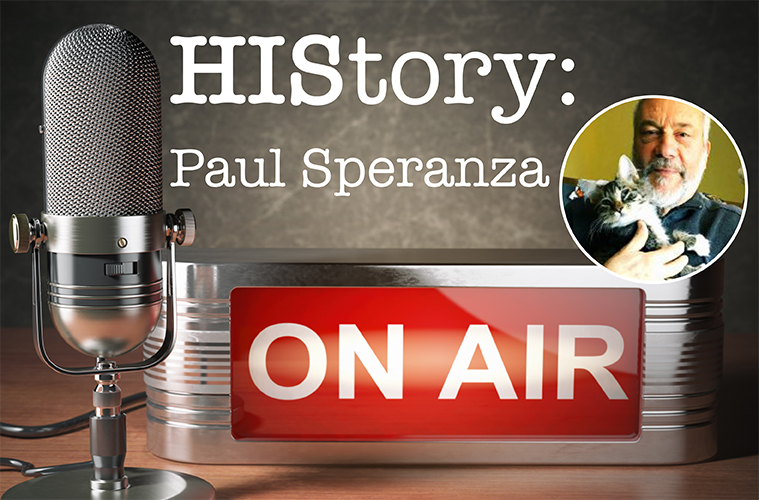 Paul Speranza has been broadcasting the weather in radio since 1970. He is a man of infinite curiosity and hope. While growing up in Connecticut, he was fascinated by the ever-changing weather – and frustrated by the fact that the TV weather forecasters don’t always get it right! I caught up with Paul in between his daily weather broadcast to get HIStory: Paul Speranza.
Paul Speranza has been broadcasting the weather in radio since 1970. He is a man of infinite curiosity and hope. While growing up in Connecticut, he was fascinated by the ever-changing weather – and frustrated by the fact that the TV weather forecasters don’t always get it right! I caught up with Paul in between his daily weather broadcast to get HIStory: Paul Speranza.
Paul told me “I studied weather in Stanford, Connecticut and I studied business in college. Plus, I’ve always just enjoyed watching the weather. So, when my mother asked me what I was going to do with my life, I said, I’m going to be better at forecasting the weather than the pros on TV.” So, that’s how his story begins.
Paul began by keeping a weather almanac. Then, he reached out to others who liked his approach and they began sharing information. Paul contends that “In life, you meet a lot of people, you ask them what you want to know, and they will help you.”

From there, Paul started what he calls the Rain Observation Program. This involves people across the country who have invested in the correct professional equipment and mirror Paul’s fascination with climate. Using their own tools, they report their findings daily to Paul. From there, Paul compiles the information and shares it with the larger community, via radio station WTZQ – ‘Your Q-munity Radio Station’.
Paul ‘weathers’ a health challenge
Paul’s story took an unexpected turn awhile back. One day, he woke up to find himself unable to urinate. Talking himself out of panicking, he endured it, hoping it would go away.
“When I looked down, my stomach is so swollen I couldn’t even see my toes.” A lot of women have experienced this during pregnancy, but men?!
Looking back, Paul can make light of how he looked … “Remember that old Arnold Schwarzenegger film where he was pregnant?” (I do. In the film, Arnold was shocked and hilarity ensued however, that wasn’t the context Paul’s story.) He continued to tell me “It’s not funny in real life when a healthy man looks pregnant because of urine retention!”
“I kept thinking maybe it would fix itself but by the next morning, I was in so much pain that it was hard to get out of bed.” Paul remembers with a grimace. “By the time I got to the doctor, I was holding 1.75 liters of water. That’s more than 2 wine bottles!”
After Paul’s bladder was drained, he was released with an indwelling urinary catheter and collection bag. “I was told to check back in a week to see if I could go on my own.”
Predictably, following the removal of the indwelling catheter, Paul was back in the same situation. By 6:00 am the next morning, he couldn’t urinate or see his toes beyond his bloated stomach. The doctor told him to immediately come back to the office.
“This time they gave me a choice” says Paul, a note of frustration entering his voice. “They told me I could have surgery in 2 ½ weeks, or I could insert 16 inch ‘tubes’ (intermittent catheters) into my body multiple times a day to go to the bathroom. I wasn’t crazy about either option.”
Paul’s first reaction to a male intermittent catheter was typical of most men. “At first, I told those doctors ‘No way!’. When they persisted, I told them I didn’t need something 16 inches long. They smiled at my joke but told me to try it. Sure enough, after inserting about 14 inches of the catheter, urine came flowing out! It was a relief.”
When asked if using an intermittent catheter was as painful as he had imagined, Paul takes a minute to think, then replies, “At first, yes. Especially pulling it out, that was no pleasure. But it didn’t take long to learn what product works best for me to avoid any discomfort. As of today, it is working good. I use the catheter, wrap it up, and throw it in the trash. It’s easy.”
It is in Paul’s nature to share information; to reach out to others if he thinks he can help. Now that he uses an intermittent catheter to maintain bladder health, he has discussed the topic with other men with honesty and a bit of humor.
“Most guys say that there’s no possible way they could use a catheter. When I tell them that it’s 16 inches long, they put their hands up in the air and walk away.” Paul laughs, remembering those reactions.
He continues in a more serious tone, “I think it helps when I tell guys how I got used to it.
For me, it’s not a big deal to use a catheter, wrap it up, and throw it in the trash.”
Grateful for the pre-lubricated Cure Ultra catheter that helped him, Paul wrote to Cure Medical, thanking them for their excellent products.
“I wrote to them just to let them know that they have a great product that helped me out a lot. They asked if I’d be willing to share my story to help other guys who might be in the same situation. I’ll be 70 in March. I’m old but not too old to try to help someone – just like many people helped me. That’s why I am happy to talk about my experience. I hope it helps someone.”
Paul has good advice that he shares. “I never expected to have this problem. One day I was able to go, the next day I couldn’t … Not for a thousand bucks could I go!
“I never even thought about my prostate until the day I couldn’t go to the bathroom. Now, I think all men should know that if you can’t urinate, get medical attention right away … If you have to use a catheter, don’t worry – you’ll get used to it. I did.”
While interviewing Paul, it was clear that he is not one to look at the downside for very long and I understand why a nurse once said of him – “If more people had your personality, Paul, my job would be easier!” Highlighting Paul’s positive attitude and desire to help others seems like a great way to share History: Paul Speranza.


